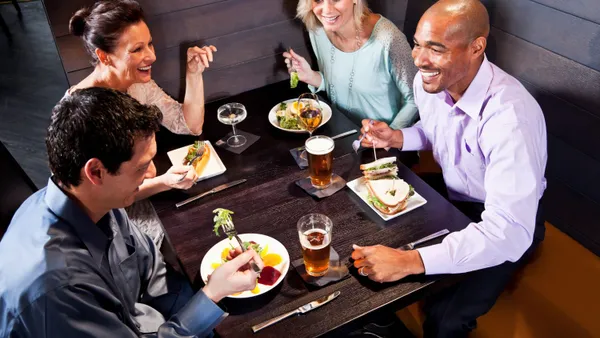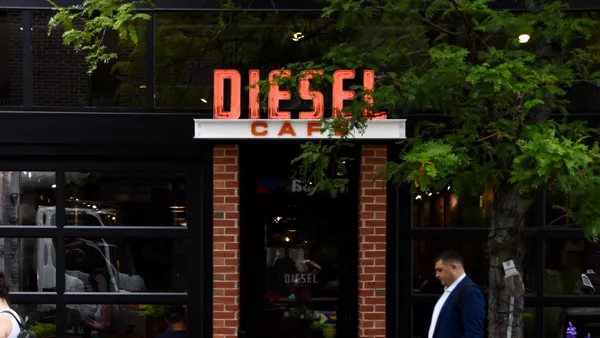Dive Brief:
- Sixty-four percent of diners say that seeing staff taking safety precautions and wearing personal protective equipment are the most important factors as restaurants resume on-premise service, according to a Toast survey emailed to Restaurant Dive.
- Additionally, 52% of survey respondents believe that cleanliness of tables, surfaces and menus will be their biggest concern while dining out at restaurants during and after COVID-19.
- Consumers (37%) also report that drive-thru availability is the most important technology during and after the pandemic, while contactless/mobile payment availability (34%), pay-at-the-table technology (33%) and online ordering (33%) are also important.
Dive Insight:
The percentage of consumers who want to see restaurant staff taking safety precautions and wearing personal protection equipment far outpaces other efforts like hand sanitizer at the table (49%), single-use menus (40%), contactless payment (38%), single-use utensils (37%), a statement about cleaning procedures posted in the restaurant (37%) and order-at-the-table capabilities (33%).
Fortunately, safety and cleanliness are also a priority for operators. Research conducted in mid-July by Black Box Intelligence found that 96% of them require masks for all restaurant staff. Most restaurant operators are also complying with social distancing measures by removing certain tables (86%), checking employee temperatures (77%), requiring all staff to wear gloves (71%) and adding plexiglass barriers (57%).
Likely because of this, some restaurant brands have started dedicating labor to ensure safety protocols. Denny's and Cava, for example, have hired "sanitation specialists" and "cleaning concierges," respectively.
Judging by which technologies customers deem most important to their dining experience in a post-COVID world, contactless interaction is a big deal. The drive-thru became a critical channel during the crisis as nationwide stay-at-home orders went into place and dining rooms were forced to close, and that won't likely change anytime soon. Major concepts like Chipotle, Shake Shack and Wawa are prioritizing drive-thrus in their near-term development plans. Shake Shack, in fact, plans to open its first drive-thru in 2021.
"This country has proven that the drive-thru in its old form works," Randy Garutti, Shake Shack CEO, said during the company's Q2 earnings call. "We want to do it better than ever."
This focus on contactless extends beyond the drive-thru, too, as illustrated by Starbucks adding more payment options through its mobile loyalty program and the massive adoption of online ordering across the industry in general.
Though many of these changing consumer preferences have become abundantly clear based on their habits during this crisis, that doesn't mean it's a cheap endeavor for restaurants trying to keep pace. During Darden Restaurant's Q4 earnings call in late June, for example, executives noted that the company incurred over $5 million specifically for incremental cleaning supplies and personal protective equipment related to COVID-19.
Toast's survey explored consumers' willingness to pay increased menu prices to offset some of these added costs, and only 20% said they weren't willing to pay more. Most — 35% — said they would pay $2 to $5 more. This response might be good news for restaurant operators trying to keep their businesses alive while also balancing the quickly changing and costly demands of consumers.
Still, the true implications of COVID-19 on the economy have yet to be revealed. While the current unemployment rate is at a historic level, the $600-a-week federal benefit expired July 31. Plenty of executives acknowledged that the stimulus had a positive impact on restaurants. Now that it has gone away, consumers might be a bit less willing to subsidize the very things they want more of, like safety equipment and contactless technologies.














